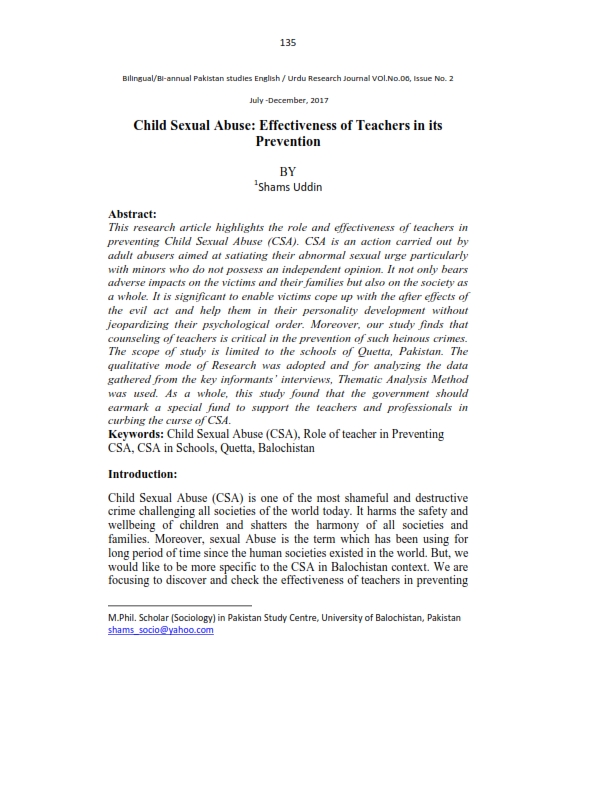Child Sexual Abuse Effectiveness of Teachers in its Prevention
Keywords:
Child Sexual Abuse (CSA), Role of teacher in Preventing CSA, CSA in Schools, Quetta, BalochistanAbstract
This research article highlights the role and effectiveness of teachers in
preventing Child Sexual Abuse (CSA). CSA is an action carried out by
adult abusers aimed at satiating their abnormal sexual urge particularly
with minors who do not possess an independent opinion. It not only bears
adverse impacts on the victims and their families but also on the society as
a whole. It is significant to enable victims cope up with the after effects of
the evil act and help them in their personality development without
jeopardizing their psychological order. Moreover, our study finds that
counseling of teachers is critical in the prevention of such heinous crimes.
The scope of study is limited to the schools of Quetta, Pakistan. The
qualitative mode of Research was adopted and for analyzing the data
gathered from the key informants’ interviews, Thematic Analysis Method
was used. As a whole, this study found that the government should
earmark a special fund to support the teachers and professionals in
curbing the curse of CSA.
References
Ali, M. I. (2015). Child Sexual Abuse Prevention and Elimination in
Pakistan . Islamabad.
Beridiansyah. (2014). Police Role in Providing Legal Protection against
Children as Victims of Sexual Abuse. Journal of Law, Policy and
Globalization , 41.
Beverley Hancock, E. O. (2009). An Introduction to Qualitative Research.
NIHR , 39.
Crosson-Tower, C. (2003). The Role of Educators in Preventing and
Responding to Child Abuse and Neglect. U.S: U.S. Department of
Health and Human Services, Office on Child Abuse and Neglect.
Dr. Kausar Perveen, M. M. (APRIL 2013). The Role of Teachers and
Parents in the Social Development of Children with Hearing
Impairment and Transforming them as a Potential Being of
Society. INTERDISCIPLINARY JOURNAL OF
CONTEMPORARY RESEARCH IN BUSINESS.
E Driver, A. D. (1989). Child Sexual Abuse, Feminist Perspectives.
United Kingdom: Macmillan Education Ltd London, RG21 2XS,
England.
FRANK W. PUTNAM, M. (March 2003). Ten-Year Research Update
Review: Child Sexual Abuse. J. AM. ACAD. CHILD ADOLESC.
PSYCHIATRY, 43.
Hassan, A. (March 2017). Child sexual abuse increased by 10pc in last
year. Islamabad : DAWN News .
IRIN. (21 February 2001). IRIN Special Report on child sexual abuse.
RAWALPINDI, : IRIN .
KabeerFeed. ( MAY 27, 2016). Paradise Lost: Personal Accounts of Child
Sex Abuse Victims. Islamabad: KabeerFeed.
KIMBERLY RENK, L. L. (January 1, 2002). Prevention of Child Sexual
Abuse, Are we Doing Enough?
Laura K. Murray, A. N. (2014 ). Child Sexual Abuse. PMCID.
Light, D. 2. (2016). CHILD SEXUAL ABUSE STATISTICS. UK: D2L
Orgnization.
Malik, Y. (28 March 2016). Scarring innocent minds: the horrors of child
abuse in Pakistan. ISLAMABAD: Dunya News.
Qadir, I. (Dec. 5, 2013). Sexual abuse of Pakistani children linked to
social factors. Lahore : UPI.
Stoltenborgh, v. I.-K. (May 2011). A global perspective on child sexual
abuse: meta-analysis of prevalence around the world. PMID.



